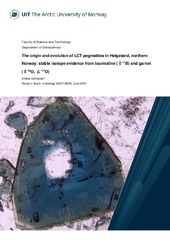| dc.description.abstract | The processes leading to formation of rare-element enriched granitic pegmatites are controversially debated amongst petrologists and economic geologists. Two contrasting genetic models discuss the necessity of a parental granitic pluton as the magma source versus an anatectic origin via partial melting of metasedimentary rocks. Geochemical tools such as the analysis of stable isotopic compositions can be applied to trace the origins and evolution of pegmatite-forming magmas. In this MSc thesis, analyses of the boron isotopic compositions of tourmaline and the triple oxygen isotopic compositions of garnet from granitic pegmatites were combined with their mineral major and trace element compositions to evaluate the tectonomagmatic evolution of the North Helgeland pegmatite field (Nordland county, northern Norway). The magmatic-hydrothermal evolution of this LCT-type pegmatite field is constrained by a more detailed investigation of the previously mined pegmatite body at Ågskardet.
Tourmaline compositions in the selected pegmatite bodies vary between dravite in the upper pegmatite at Ågskardet, schorl at Grønnøya, Ørnes and in outer zones of the Ågskardet old quarry pegmatites, and F-schorl to F-rich elbaitic, tsilaisitic and F-liddicoatitic compositions in the inner zone of the Ågskardet old quarry pegmatite. Lithium contents in tourmaline increase from the outer to the inner pegmatite zones. Tourmaline from the inner zone is enriched in Sr and Pb compared to all other tourmaline crystals studied, and it shows complex replacement textures. Garnet in the North Helgeland pegmatites is dominated by almandine and spessartine components. Except for garnet from the old quarry pegmatite at Ågskardet, the garnet crystals are enriched in HREE.
Tourmaline δ11B values range from -15.5 to -1.9 ‰ (± 0.9‰, 1-sigma). For tourmaline from the two pegmatite bodies at Ågskardet, the range in δ11B corresponds to values typical for S-type granites, whereas slightly heavier values were obtained for tourmaline from the pegmatites at Grønnøya and Ørnes. The higher δ11B values may be explained by a larger proportion of I-type granitic basement in the crustal source to the granitic pegmatite-forming magmas. Within the old quarry pegmatite at Ågskardet, isotopic fractionation between minerals-melt, melt-fluid and fluid-minerals likely played a role in the observed tourmaline δ11B variations. Garnet δ18O values range from 5.03 to 11.15 (± 0.1‰, 1-sigma). These values broadly coincide with the whole-rock δ18O range displayed by Paleoproterozoic basement gneisses in the study area. Triple oxygen isotope data (-76 to -56 ± 0.4 ppm Δ'17O, 1-sigma) for pegmatitic garnet reveal a trend with a slope of 0.527 in linearized triple oxygen isotope space. This slope defined by fresh magmatic garnet crystals indicates low-temperature oxygen isotope fractionation, which
II
is consistent with and affirms contributions from an anatectic melt sourced from metapelitic rock units.
Tourmaline δ11B compositions, garnet δ18O compositions and triple oxygen isotope data are consistent with the North Helgeland pegmatites being produced by partial melting of a heterogeneous crustal source, which contained varying amounts of Paleoproterozoic metasedimentary rocks intruded by ca. 1.8 Ga old granitic orthogneisses of the Transscandinavian Igneous Belt. Oxygen isotope thermometry performed on garnet-quartz pairs yielded apparent temperatures of 585 (± 25 °C, 1-sigma) for the old quarry pegmatite at Ågskardet, 588 (± 25 °C, 1-sigma) for the Grønnøya pegmatite, 823 (± 53 °C, 1-sigma) for the Neverdalen pegmatite and 532 (± 20 °C, 1-sigma) as well as 1139 (± 115 °C, 1-sigma) for two separate samples from the upper pegmatite at Ågskardet. These contrasting values likely indicate disequilibrium conditions in the upper pegmatite. Tourmaline B-isotope variations and trace element characteristics within the old quarry pegmatite at Ågskardet indicate a transition from the main magmatic stage to a late stage dominated by a hydrosaline melt or fluid. This led to crystallization of tourmaline with F-rich elbaitic, tsilaisitic and F-liddicoatitic compositions, as well as to formation of Li-Rb-Cs enriched micas found as inclusions in late-stage tourmaline. Possibly, an aqueous fluid led to changes in the compositions of the rims of these complex tourmaline crystals. The late-stage paragenesis of LCT-type pegmatites presents a favorable exploration target (i.e., the Ågskardet old quarry occurrence), but the vast majority of pegmatite bodies in northern Helgeland have not reached such an advanced stage in their magmatic-hydrothermal evolution. | en_US |


 English
English norsk
norsk
